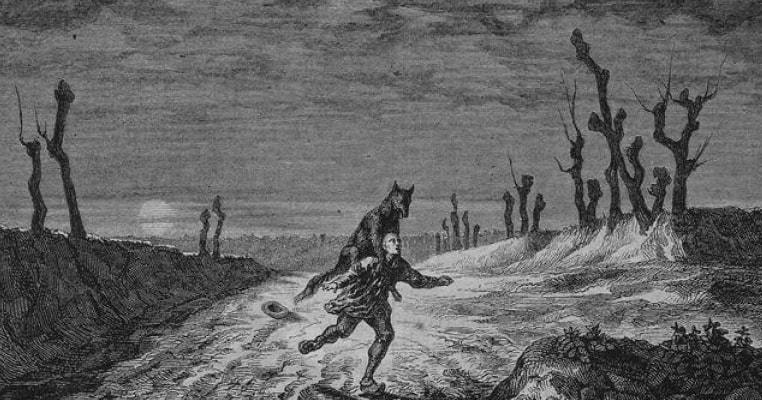Werewolves are present in legends around the world. They were men with the ability (or compulsion) to turn into wolves, either through being bitten by a (were)wolf or through a satanic pact. The term ‘werewolf’ comes from the Old English werwulf, a compound noun of wer (‘man’) and wulf (‘wolf’), but the other term, lycanthropy, is much older. ‘Lycanthropy’ (Ancient Greek lykos (‘wolf’) and thropos (‘man’) is a reference to King Lycaon, the earliest recorded Western werewolf who, according to Ovid writing c.8AD, was transformed into a wolf by Zeus after the monarch failed to recognize and worship him.
Werewolves have obvious symbolic overtones. Man and wolf have long been enemies, and culture has typically seen the two as opposites: the essentially good and rational man, and the inherently evil and irrational wolf. To call someone a wolf was rarely a compliment (warriors excepted): in Anglo-Saxon law, outlaws were known as wulfheafod (‘wolf head), a reference to an earlier custom of tying a wolf’s head around anyone whose life was forfeit. Beyond allegory, however, history also furnishes us with supposedly genuine tales of werewolves who were discovered, tried, and usually executed. Read on for 12 bone-chilling instances of ‘real’ werewolves.

The Gandillon Werewolves
The Gandillon Werewolves were a family who, in the late 16th century, were accused and executed for being werewolves. In 1598, a young girl and her brother were attacked by a wolf. Benoist Bidel, aged about 15, had climbed a tree to pluck some fruit and, whilst aloft, saw a wolf dart from some bushes and seize his sister. Leaping down to protect her, Benoist drew his knife. The wolf rushed at him and drove the knife into his neck with a savage blow of the paw. Fortunately, a crowd had heard the commotion, and chased the wolf away.
The girl died at the scene, and Benoist was taken back to his father’s cabin, where he died of his injuries a few days later. Before he died Benoist claimed that the wolf that attacked him had hands, like a man, covered with hair. The wolf had been maimed by the crowd, and so suspicion fell upon one Perrenette Gandillon, who exhibited a wound in precisely the same place as the wolf had been injured. Unfortunately for her, one of the crowd that injured the wolf was none other than Henri Boguet (1550-1619), a notoriously merciless witch hunter.
Boguet arranged a mob, and executed Perrenette shortly thereafter. However, as he later revealed in his Discours des Sorciers (1602), there were rumors that the whole family practiced black magic, and so Boguet had them all arrested. Perrenette’s daughter, Antoinette, swiftly confessed to witchcraft, but her brother, Pierre, and his son, George, were not so forthcoming. Placed under observation, Boguet recounts how he saw them walk around on all fours, barking, and howling, and covered in mysterious scratches. Boguet questioned them whilst they were behaving like this, and they confessed to witchcraft. The Perrenette family were burned at the stake.
Boguet boasted of having tried and executed 600 werewolves in his career (according to Voltaire), and his writings are full of lycanthropic examples. Another notable case was that of Claudia Gaillard, later dubbed ‘the Werewolf of Burgundy’. Claudia was walking through the woods with Jeanne Perrin, grumbling about receiving so few alms, when she darted into the bushes, and a wolf emerged. Jeanne dropped her alms, crossed herself, and fled the scene, later revealing that the wolf had toes like a human. When Claudia advised Jeanne that the wolf would not have harmed her, she was tried and executed.

